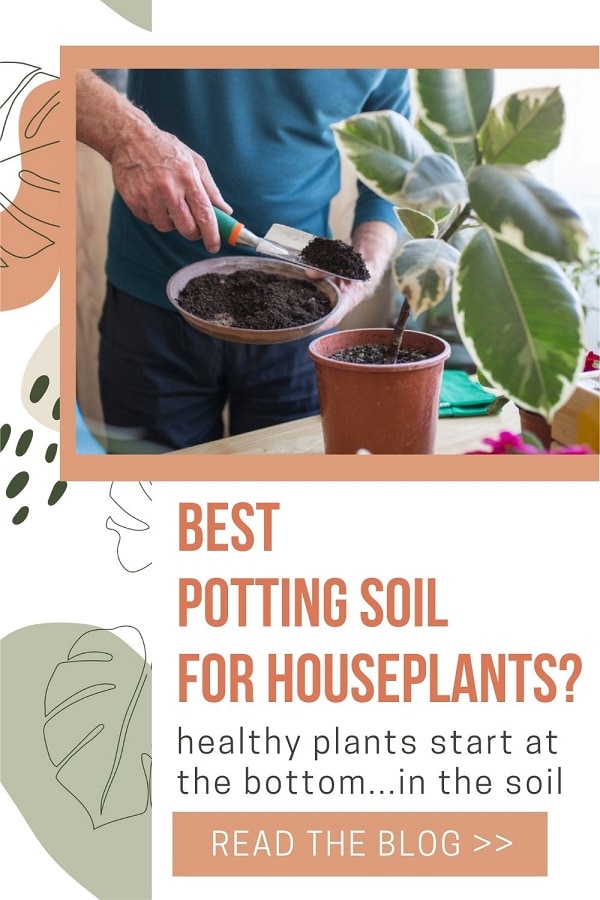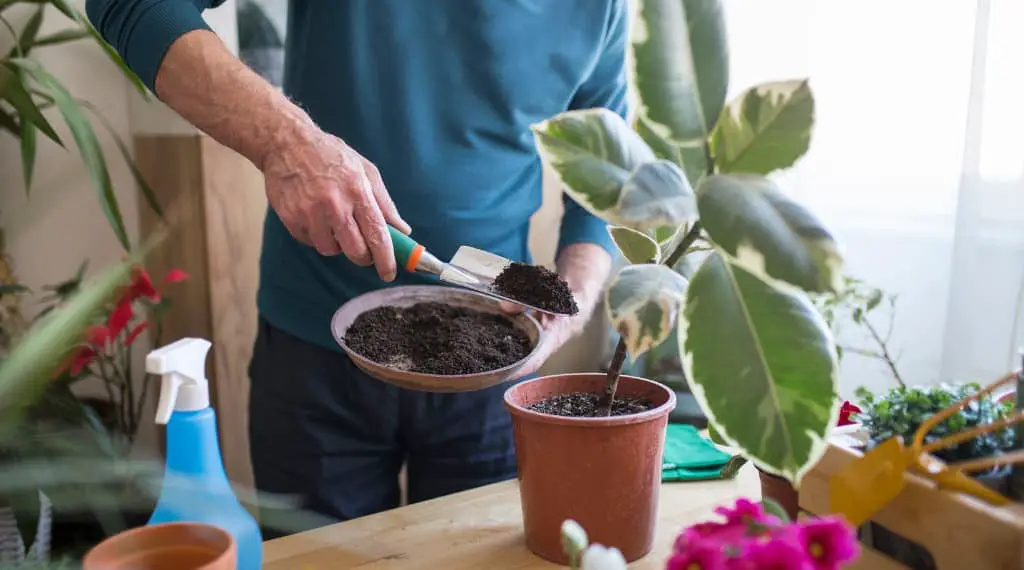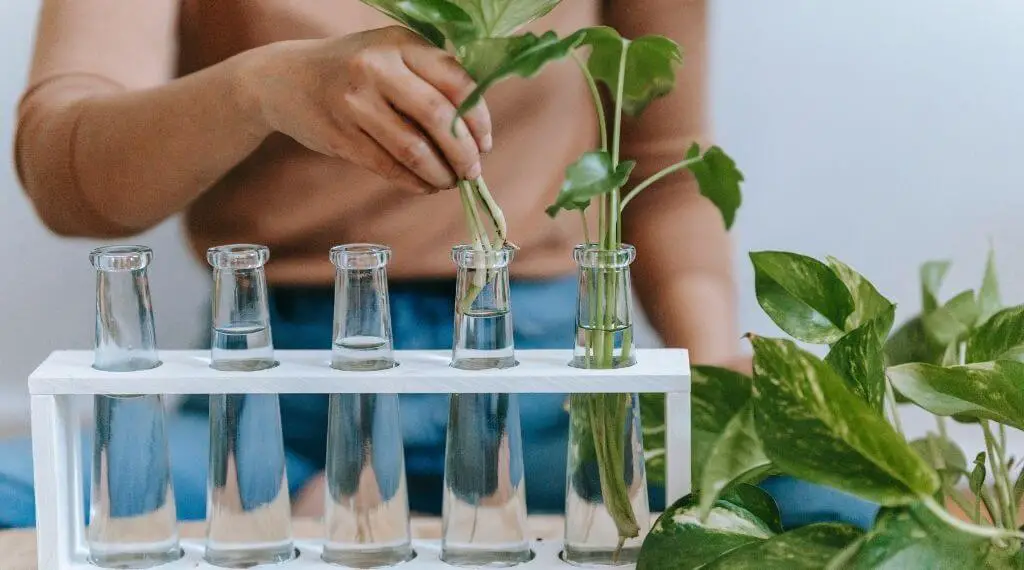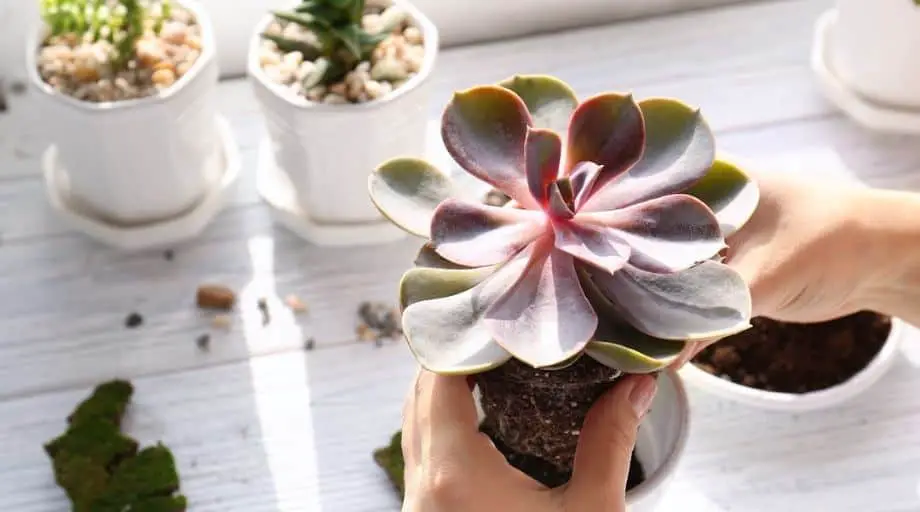Last Updated on October 5, 2021 by Plantiful Interiors
Choosing the Best Potting Medium for Indoor Plants
Finding the best potting soil for houseplants is essential for their survival. Houseplants are fantastic additions to any home- they look great and they also help clean the air, bonus! But without the proper soil, they won’t be pretty or provide fresh air to breathe because they simply won’t survive.
The best potting soil for houseplants is dependent on the type of plant. For example, low-maintenance plants like pothos are happy to grow in a common potting mix. On the other hand, more finicky houseplants like succulents and orchids need a specialty potting mix.
If you want to keep houseplants alive and healthy, then you need to start at the bottom…with the soil. Keep reading for different kinds of potting soil and which potting soil is the best for the type of plant you’re growing.
Different Types of Potting Soil
If you’ve ever found yourself standing in front of an overwhelming number of potting medium options in the gardening department thinking, “I had no idea there were this many kinds of dirt,” you’re not alone. But underestimating the power of choosing the correct soil for your houseplants is a fatal move.
The potting mix is the foundation for your plants, and picking the wrong one will inevitably lead to unhealthy and eventually dead plants. Sorry for the doom and gloom, but too many believe that dirt is dirt and go with the least expensive (or easiest to reach) option. But don’t worry, up next we’ve got a guide to all the different kinds of potting soil so that you can choose the best for your plants.
This site features affiliate content. As an affiliate partner of various brands, we earn commissions on qualifying purchases, at no extra cost to you. Please read our disclaimer for more information.
Potting Soil vs Potting Mix
One of the first, and most common, questions when choosing a medium to plant your houseplant in is “what is the difference between potting soil and potting mix?”.
To put it simply, potting soil is typically just dirt, whereas potting mix is composed of peat or coco coir along with additional ingredients such as perlite, bark and/or vermiculite – most times containing no actual soil at all. The additional ingredients in a potting mix help keep the soil light and airy, allowing water to drain properly and prevent the dirt from becoming too compact.
Before purchasing any potting medium, read the ingredients listed on the package to know if you’re getting strictly potting soil or potting mix. Also, check the bag for any damage or signs that the potting soil may be spoiled.
For indoor plants, you’ll typically want to purchase a potting mix, we recommend a few different options below based on the type of plant you’re growing.
Potting SoilÂ
As we mentioned earlier, potting soil is typically just soil and is more suited for outdoor gardens. Potting soil doesn’t have any of the additional ingredients that a potting mix has, which is why it’s not always the best option for houseplants.
That said, potting soil can be used as the base for a DIY mix or if you plan to add a bit of perlite or other ingredients to it for increased aeration and drainage. This type of basic planting medium could be used for plants that don’t require a ton of extra nutritional value or help with drainage.
Here are a few indoor plants that are low maintenance and easy to grow that could (though not recommended) be planted in potting soil.
- English Ivy
- Spider Plant
- Pothos
- Cast Iron Plant
Top Pick

This expanding soil brick is a good option because it yields a large amount of soil from just a small brick. It’s easy to use and affordable.
Pros
- Inexpensive
- Makes up to 2 gallons of potting soil
- Organic
Cons
- No additives for increased drainage
- Not suitable for needy plants
BUYING TIP:
If the bag feels heavy and dense, it is likely the main ingredient is soil.
If you’re looking for something that has better drainage, look for a bag that is light weight and lists the ingredients to know if you’re getting strictly soil, or a mixed blend. Again, for indoor plants, look for something that doesn’t contain soil at all and has the main ingredient of peat or coco coir.
Potting Mix
Potting mixes typically use peat or coco coir as the main ingredient, but it is also blended with other ingredients to create a fluffy and light potting medium.
Peat is known to retain moisture, while providing enough air space for healthy roots to grow.
Potting mixes usually contain other ingredients, such as perlite, bark and/or vermiculite, that aid in draining and lead to the soil’s decomposition.
When buying a potting mix, read the ingredients to see what all is in the package. If your plant requires well draining soil, such as many tropical indoor plants do, opt for a mix that has a good combination of peat moss, perlite and bark.
A potting mix should be used for houseplants that need regulated draining but are also okay with being repotted in a new home every year, like these:
- Monstera
- Calathea
- Ferns
Top Pick
Miracle-Gro Expand N’ Gro Concentrated Planting Mix

Miracle-Gro is a tried-and-true brand that delivers on quality. This particular potting mix is meant to hold more water than soil. It also expands as it retains water, allowing more air into the mix.
Pros
- Low pH for plants that like acidic conditions
- Drainage control absorbs and releases water as needed
- Maintains density, doesn’t compost as fast as other potting mixes
Cons
- If there are additional fillers, the mix will turn mushy and decompose even faster
- Some mixes contain crystals and other fertilizers
Potting Mix Tip:
If your plant is healthy and thriving, rather than replacing all of the soil every 12-18 months, only swap out the top 1/3 for a fresh mix. However, if you suspect root rot or notice the mixture has become hard and compacted, it’s time to repot into new fresh mixture.
Cactus and Succulent Mix
Whoever said succulents are hard to kill is a liar. Succulents and cacti are two of the neediest plants you’ll ever own, at first anyway. Once you get them settled in their pots with the proper soil and make sure they have just the right light, they’re much less needy. But starting with the proper soil is the only way to ensure they stay alive.
Although cacti and succulents need a type of potting mix to survive and thrive, other houseplants need similar growth conditions, so they also use this same soil. These include:
- Palms
- Jade Plants
- Citrus
- Aloe Vera
Top Pick
Espoma Organic Cactus Potting Mix

This soil blend is specially crafted for cacti and succulents and their fellow houseplants that appreciate optimum drainage. The combination of ingredients includes peat and others like sand, to ensure there’s no extra moisture trapped inside.
Pros
- Organic
- Regionally sourced ingredients
- Well aerated
Cons
- Doesn’t contain agents that prevent pests and fungus from finding a home in the soil
Related Reading: 10 Best Succulents For Your Office
African Violet Potting Mix
While some African Violet potting mediums might have a little bit of soil, for the most part, they contain a mix of perlite and vermiculite, with some peat moss mixed in as well. African Violets like to keep it light in the soil department, so the airier, the better.
African Violet soil alone might be sufficient for some cacti and succulents, it won’t work for many other plants. But, it can be used to mix with peat or coco coir to be used for potting other plants that like light, fluffy, well-aerated soils.
Top Pick
Sun Gro Horticulture Black Gold African Violet Mix

This is a favorite because it contains a secret ingredient: worm castings! Vermicompost is an excellent natural fertilizer for plants, but it’s not something that everyone wants to make on their own. It also contains a pH adjuster to keep your African Violets happy.
Pros
- Contains dolomite lime for a natural pH balancer
- Natural fertilizing agents
- Medium works well for other tropical plants
Cons
- no cons to note when using for African Violet plants
Orchid Potting Mix
Orchids are another picky flower when it comes to soil. They prefer a much more acidic medium. But they also like a very coarse, mixed medium with barks, moss, and other fibrous components like coconut skins.
Some other plants flourish in orchid soil. Many of them are lovely tropicals, so they’re temperamental beyond what they are planted in. But they sure do make beautiful houseplants if you’re committed to taking care of them:
- Bird’s Nest Ferns
- Christmas Cacti
- Bromeliads
- Tillandsia
Top Pick

This particular mix is hand-blended for maximum draining capacity, just what the orchids ordered. It’s made of charcoal, bark, and perlite to allow increased drainage and airflow.
Pros
- Comes in a package with enough soil to grow 2-3 medium orchids
- All-natural ingredients
Cons
- Doesn’t contain any pest or fungal repellent; orchids are very susceptible to both
DIY Potting Soil for Indoor Plants
One of the biggest benefits to making your own potting mixture for your houseplants is that you’re in control of the ingredients and quantities.
Some things you’ll need are:
- Peat moss or coco coir
- Pumice or perlite
- Worm castings
Here’s a great DIY potting soil recipe from Planterina.
Importance of Drainage Based on Plant Type
Part of the reason that soil is such an essential part of plant life is the draining factor.
Each plant species has different watering and moisture needs, so there’s no one-size-fits-all soil. Some plants prefer constantly moist soil, while others need to dry out completely or they’ll get root rot.
Here we have different types of drainage provided by soil and the houseplants that do best with each kind:
| Drainage | Type of Houseplants |
| Sandy, well-draining soils that hold little to no moisture | Cacti Succulents Citrus Palm African Violets |
| Moist potting medium, not wet | Spider Plants Aloe Vera Pothos Philodendrons |
| Wet, borderline water-logged soil | Baby’s Tears Cyperus Boston Fern |
Related Reading: Are Terracotta Pots Good For Houseplants – Everything You Need To Know
Potting Soil FAQ
u003cstrongu003eHow do I dry out houseplant soil?u003c/strongu003e
If your plants are sitting in overly wet soil, try one of these solutions to dry out the soil and give those roots a chance to breathe:u003cbru003eu003cstrongu003eAdd light: u003c/strongu003eMove your plant to a window where it can get more light to help dry out the soil. (But not the bathroom; you want to avoid extra humidity.)u003cbru003eu003cstrongu003eAir dry: u003c/strongu003eIf you suspect the soil is really wet, you can carefully remove the plant from its pot and let it dry out. Wrap the soil and roots in a newspaper or paper towel to keep everything intact while wicking away moisture.u003cbru003eu003cstrongu003eRepot:u003c/strongu003e In severe cases, a fresh batch of soil, or even a separate pot entirely, is the only cure. Just be careful not to disrupt the roots when repotting. u003cbru003eu003cbru003eEven though some plants are okay with wet soil, not having proper drainage can cause all kinds of other issues. Super wet soil is the perfect residence for fungi and even bugs. Gnats are especially fond of these soil conditions. But also, wet soil can lead to root rot in your plants.
u003cstrongu003eCan I use topsoil for houseplants?u003c/strongu003e
No, it is not advised to use straight topsoil for growing houseplants. Topsoil doesn’t allow the proper drainage that most houseplants need. But, if you have some extra topsoil, you can use it to mix up your own batch of potting medium.u003cbru003eu003cbru003eDepending on the houseplant you’re potting, you’ll need to add the ingredients according to the draining needs. Here are some ingredients you can use for your own magical potting blend:Â u003cbru003ePeat mossu003cbru003eCoir fiberu003cbru003ePerliteu003cbru003eVermiculiteu003cbru003eWorm castingsu003cbru003eSandÂ
Final Thoughts on the Best Potting Medium for Houseplants
Plants need water to live, of course, but there is such a thing as too much water. Houseplants are picky roommates, and one of the keys to keeping them happy is making sure they have the proper amount of drainage in their soil. Choosing the best potting medium for your houseplants is the first step in ensuring they’re able to drain properly, so your houseplants can not only survive but also thrive.
Growing healthy houseplants starts by using the best potting soil for your plant type




